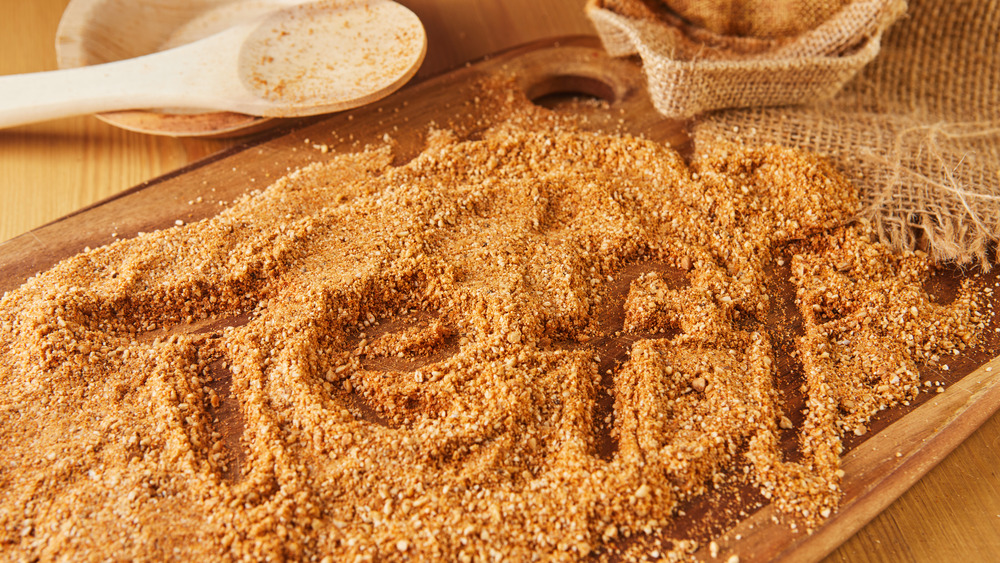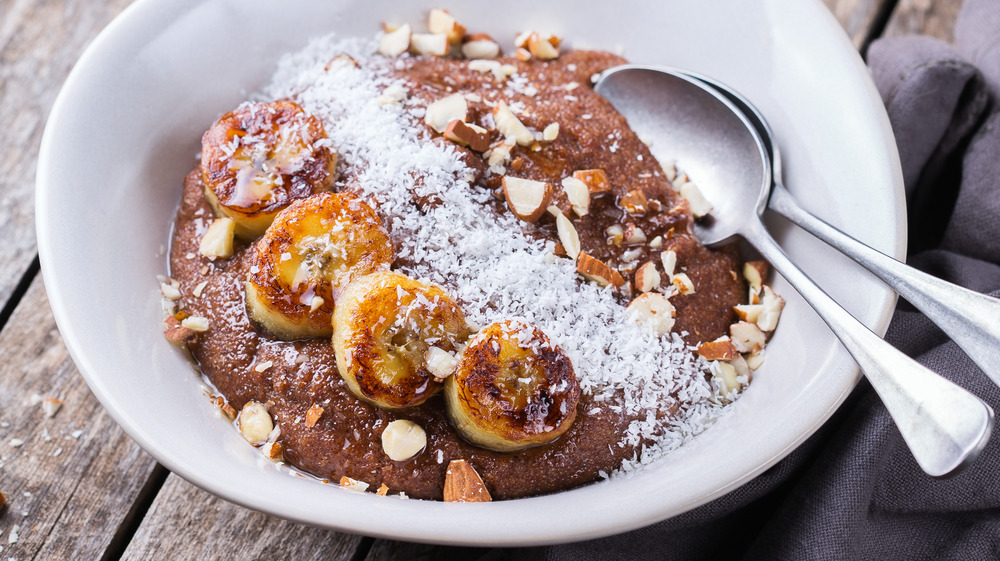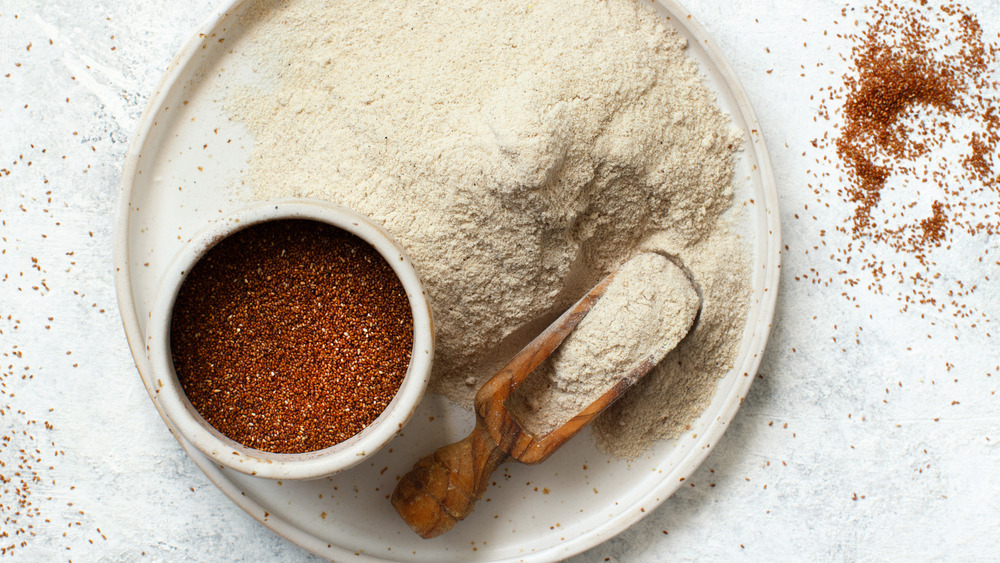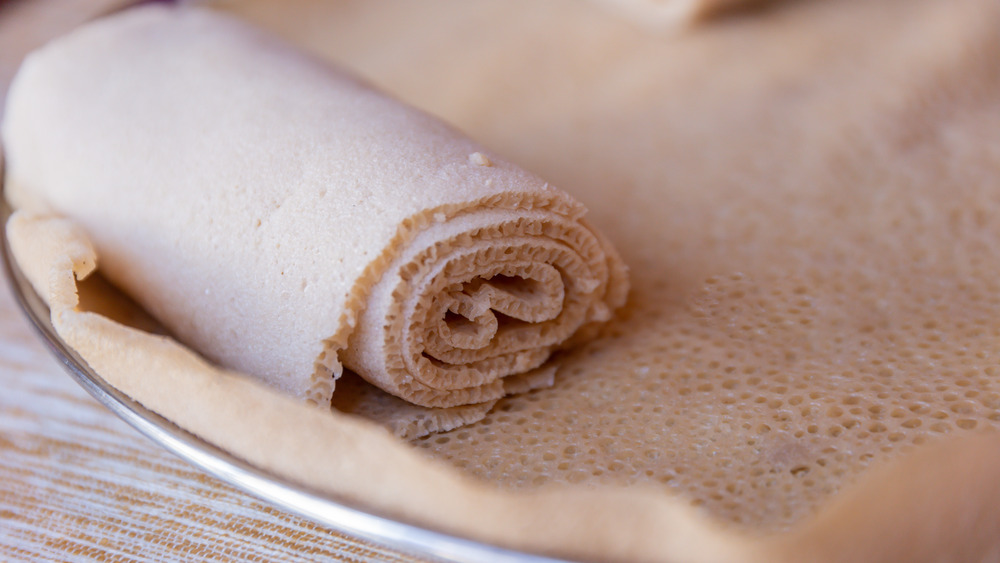Everything You Need To Know Before Cooking Teff
Was your first thought, when you read this title, "What is teff, and why would I possibly want to cook it?" Well, you're not alone. While teff, as it turns out, is not a type of industrial plastic, nor is it a wacky sitcom sidekick or a cartoon character, it's still not nearly as well-known as are other ancient grains such as quinoa, amaranth, farro, and einkorn.
Celine Beitchman, Director of Nutrition at the Institute of Culinary Education, thinks teff is an ingredient you should get acquainted with. It's been around for, oh, about the past 6,000 years or so, and is a member of the grass family, although Beitchman says only the seeds are eaten, not the grassy or leafy parts. Teff isn't as widely available as some other types of grain, nor is it all that cheap as far as grains go (Pick N'Save lists whole grain teff starting at $4.53 for 15 ounces and teff flour starting at $5.44 for a similarly-sized bag), but its flavor and nutritional profile make it well worth seeking out.
Why you should eat teff
Among the benefits of teff are the fact that it's gluten-free – Beitchman tells us that a number of GF baked goods on the market may actually contain teff. Turns out teff's pretty nutritious stuff, too. Beitchman says it's a great source of B vitamins, calcium, and iron and that "a half cup provides four grams protein and about three and a half grams of fiber."
Today's Dietitian adds that teff is a good source of dietary minerals: 3/4 cup of cooked teff can supply 22 percent of your daily requirement of magnesium, 12 percent of your zinc, and more than twice (223 percent) of your daily requirement of manganese. It is, however, low in sodium, which is usually a good thing. They also add that a 2013 study published in the Ethiopian Journal of Health found breastfeeding women whose diets were high in teff to have milk much higher in calcium and copper than those who didn't eat so much of this particular grain.
How to cook teff
While Beitchman describes teff grains as "tiny...about the size of poppy seeds," she says they cook up just like any other grain. While some recipes may say to soak teff overnight before you use it, Beitchman says that she herself hasn't seen too much difference in either flavor or cooking time whether she does or doesn't pre-soak. She does suggest, though, that if your teff keeps coming out too chewy or if it takes too long to cook, that you might try that overnight soak since it's not going to hurt anything. Just soak, drain, and proceed as usual.
As to the cooking method, Beitchman recommends cook it up just like brown rice, only using a 3 to 1 ratio of water to grain. Bring the grain/water mix to a boil in a pot, she says, then turn the heat down and simmer for 20 to 30 minutes until all of the water is absorbed. When the grains are cooked through, Beitchman tells us that "the surface of the grains will be pocked with little air holes." She explains that this is "a sign that excess water has risen to the top and popped through steam vents." and says that this is an indication that the cooked teff is ready to eat. She also notes that the cooked grains might appear to be a homogeneous mass, but says that they actually remain separate throughout the cooking process.
How to serve teff
Beitchman describes teff as having a flavor profile that is "earthy, slightly sweet and hazel-nutty, with hints of coffee and molasses." She says the grain is used in both sweet and savory dishes and as both a whole grain and a flour. What's more, it can even be fermented into beverages (some alcoholic; others not). "One of its most popular uses," says Beitman, "is in an Ethiopian fermented batter that's cooked up into a crepe-like pancake called injera." The fun thing about injera (as anyone who's ever dined at an Ethiopian restaurant can tell you) is that it a meal eaten off this bread is one that requires no plates or utensils – injera's magical power consists of transforming anything it touches into a finger food
While it is possible to screw up your teff when you cook it, Beitchman has a fix for this, too. She says that overcooked or too-wet teff can get "gummy," but should this happen, all you need to do is pour it out onto a sheet pan and let it set up. "Once [it's] set," she explains, "you can cut it into shapes and pan-fry it like polenta," adding that fried teff "is well-complemented by apples, lemon and a touch of honey" and makes a great breakfast alternative to oatmeal.



